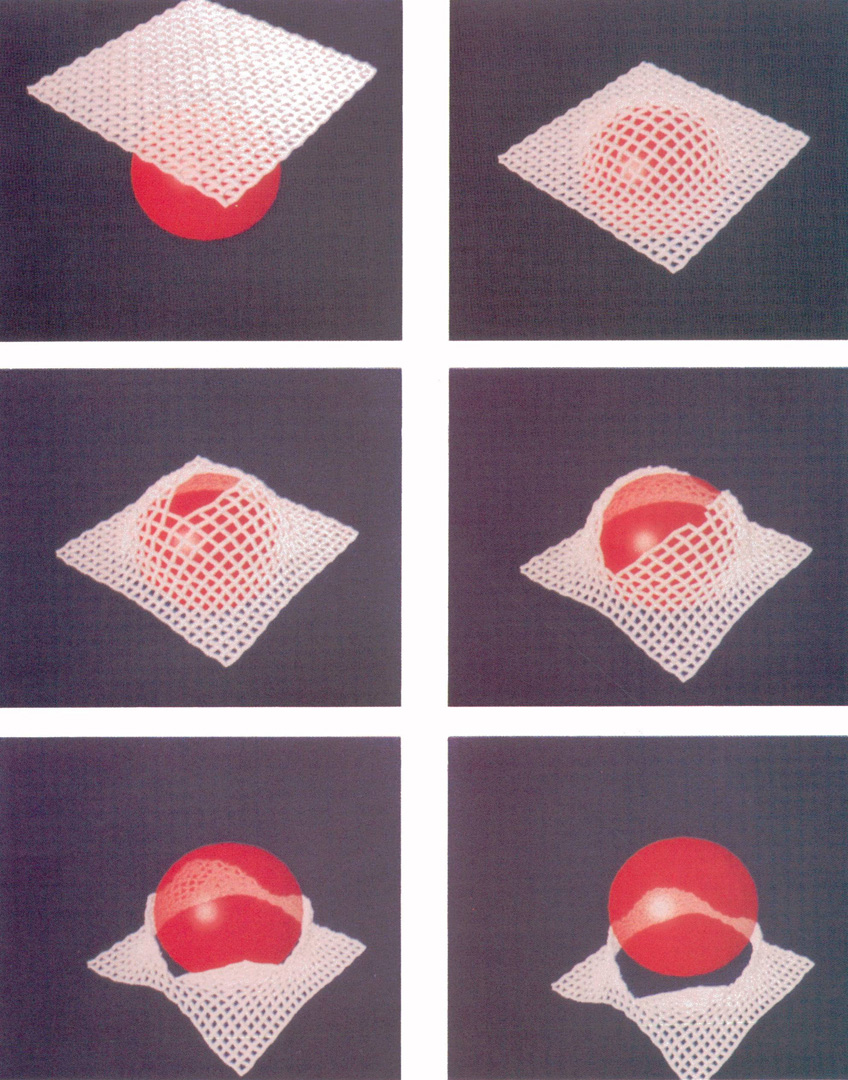“Modeling inelastic deformation: viscolelasticity, plasticity, fracture” by Terzopoulos and Fleischer
Conference:
Type(s):
Title:
- Modeling inelastic deformation: viscolelasticity, plasticity, fracture
Presenter(s)/Author(s):
Abstract:
We continue our development of physically-based models for animating nonrigid objects in simulated physical environments. Our prior work treats the special case of objects that undergo perfectly elastic deformations. Real materials, however, exhibit a rich variety of inelastic phenomena. For instance, objects may restore themselves to their natural shapes slowly, or perhaps only partially upon removal of forces that cause deformation. Moreover, the deformation may depend on the history of applied forces. The present paper proposes inelastically deformable models for use in computer graphics animation. These dynamic models tractably simulate three canonical inelastic behaviors—viscoelasticity, plasticity, and fracture. Viscous and plastic processes within the models evolve a reference component, which describes the natural shape, according to yield and creep relationships that depend on applied force and/or instantaneous deformation. Simple fracture mechanics result from internal processes that introduce local discontinuities as a function of the instantaneous deformations measured through the model. We apply our inelastically deformable models to achieve novel computer graphics effects.
References:
1. Barr, A., Barrel, R., Haumann, D., Kass, M., Plait, J., Terzopoulos, D., and Witkin, A., Topics in physically-based modeling, ACM SIGGRAPH ’87 Course Notes, Vol. 17, Anaheim, CA, 1987.
2. Fournier, A., Bloomenthal, J., Oppenheimer, P., Reeves) W.T., and Smith, A.R., The modeling of natural phenomena, ACM SIGGRAPH ’87 Course Notes, Vol. 16, Anaheim, CA, 1987.
3. Armstrong, W.W., and Green, M., “The dynamics of articulated rigid bodies for purposes of animation,” The Visual Computer, 1, 1985, 231-240.
4. Wilhelms, J., and Barsky) B.A., “Using dynamic analysis to animate articulated bodies such as humans and robots,” Proc. Graphics Interface ’85, Montreal, Canada, 1985, 97-104.
5. Girard, M., and Maciejewski, A.A., “Computational modeling for the computer animation of legged figures,” Computer Graphics, 19, 3, 1985, (Proc. SIGGRAPH), 263- 270.
6. Barrel, R., and Barr, A., Dynamic Constraints, 1987,
7. Hoffmann, C.M., and Hopcroft, J.E., “Simulation of physical systems from geometric models,” IEEE Journ. Robotics and Automation, RK-3, 3, 1987, 194-206.
8. Issacs, P.M., and Cohen, M.F., “Controlling dynamic simulation with kinematic constraints, behavior functions, and inverse dynamics,” Computer Graphics, 21, 4, 1987, (Proc. SIGGRAPH) 215-224.
9. Weil, J., “The synthesis of cloth objects,” Computer Graphics, 20, 4, 1986, (Proc. SIGGRAPH), 49-54.
10. Feynman, C.R., Modeling the Appearance of Cloth, MSc thesis, Department of Electrical Engineering and Computer Science, MIT, Caxnhridge, MA, 1986.
11. Terzopoulos, D., Platt, J., Barr, A., and Fleischer, K., “Elastically deformable models,” Computer Graphics, 21, 4, 1987, (Proc. SIGGRAPH) 205-214.
12. Haumann, D., Modeling the physical behavior of flexible objects, 1987, in {1}.
13. Well, J., “Animating cloth objects,” unpublished manuscript, 1987.
14. Terzopoulos, D., and Witkin, A., “Physically-based models with rigid and deformable components,” Proc. Graphics Interface ’88, Edmonton, Canada, June, 1988.
15. Alfrey, T., Mechanical Behavior of High Polymers, Interscience, New York, NY, 1947.
16. Kardestuncer, H., and Norrle, D.H., (ed.), Finite Element Handbook, McGraw-Hill, New York, NY, 1987.
17. Christiansen, H.N., “Computer generated displays of structures in vibration,” The Shock and Vibration Bulletin, 44, 2, 1974, 185-192.
18. Christiansen, H.N., and Benzley, S.E., “Computer graphics displays of nonlinear calculations,” Computer Methods in Applied Mechanics and Engineering, 34, 1982, 1037- 1050.
19. Shephard, M.S., and Abel, J. F., Interactive computer graphics for CAD/CAM, 1987, in {16}, Section 4.4.3.
20. Christensen, R.M., Theory of viscoelasticity, 2nd ed., Academic Press, New York, NY, 1982.
21. Mendelson, A., Plasticity-Theory and Application, Macmillan, New York, NY, 1968.
22. Sih, G.C., Mechanics of Fracture, Martinus Nijhoff, The Hague, 1981.
23. Goldstein, H., Classical Mechanics, Addison-Wesley, Reading, MA, 1950.
24. Courant, R., and Hilbert, D., Methods of Mathematical Physics, Vol. I, Interscience, London, 1953.
25. Terzopoulos, D., “Regularization of inverse visual problems involving discontinuities,” IEEE Trans. Pattern Analysis and Machine Intelligence, PAMI-8, 1986, 413-424.
26. Lapidus, L., and Pinder, G.F., Numerical Solution of Partial Differential Equations in Science and Engineering, Wiley, New York, NY, 1982.
27. Press, W.H., Flannery, B.P., Teukolsky, S.A., and Vetterling, W.T., Numerical Recipes: The Art of Scientific Computing, Cambridge University Press, Cambridge, UK) 1986.
28. Zienkiewicz, O.C., The Finite Element Method; Third edition, McGraw-Hill, London, 1977.
29. Hackbusch, W., Multigrid Methods and Applications, Springer-Verlag, Berlin, 1985.
30. Hansen, C., and Henderson, T., UTAH Range Database, Dept. of Computer Science, University of Utah, Salt Lake City, Utah, TR No. UUCS-86-113, 1986.
31. Terzopoulos, D., “Multilevel computational processes for visual surface reconstruction,” Computer Vision, Graphics, and Image Processing, 24, 1983, 52-96.
32. Fleischer, K., and Witkin, A., “A modeling testbed,” Proc. Graphics Interface ’88, Edmonton, Canada, June, 1988.





